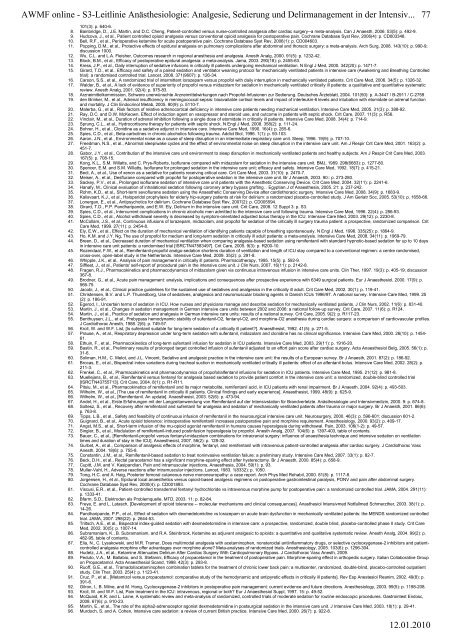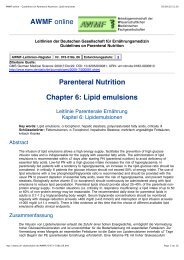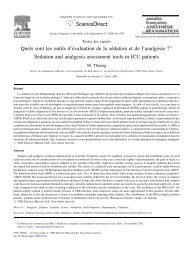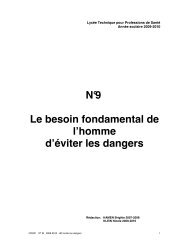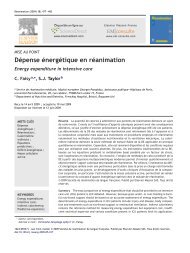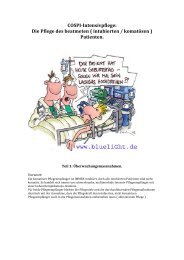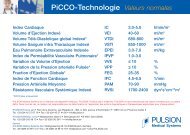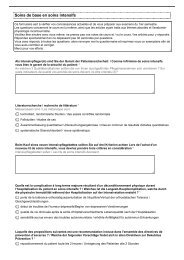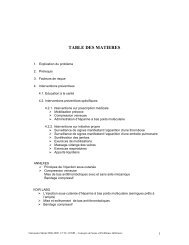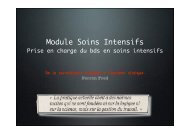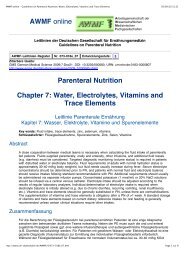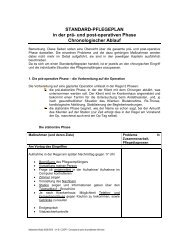Analgesie, Sedierung und Delirmanagement in der ... - Amazon S3
Analgesie, Sedierung und Delirmanagement in der ... - Amazon S3
Analgesie, Sedierung und Delirmanagement in der ... - Amazon S3
Sie wollen auch ein ePaper? Erhöhen Sie die Reichweite Ihrer Titel.
YUMPU macht aus Druck-PDFs automatisch weboptimierte ePaper, die Google liebt.
AWMF onl<strong>in</strong>e - <strong>S3</strong>-Leitl<strong>in</strong>ie Anästhesiologie: <strong>Analgesie</strong>, <strong>Sedierung</strong> <strong>und</strong> <strong>Delirmanagement</strong> <strong>in</strong> <strong>der</strong> Intensiv...<br />
101(3): p. 640-6.<br />
8. Ba<strong>in</strong>bridge, D., J.E. Mart<strong>in</strong>, and D.C. Cheng, Patient-controlled versus nurse-controlled analgesia after cardiac surgery--a meta-analysis. Can J Anaesth, 2006. 53(5): p. 492-9.<br />
9. Hudcova, J., et al., Patient controlled opioid analgesia versus conventional opioid analgesia for postoperative pa<strong>in</strong>. Cochrane Database Syst Rev, 2006(4): p. CD003348.<br />
10. Bell, R.F., et al., Perioperative ketam<strong>in</strong>e for acute postoperative pa<strong>in</strong>. Cochrane Database Syst Rev, 2006(1): p. CD004603.<br />
11. Popp<strong>in</strong>g, D.M., et al., Protective effects of epidural analgesia on pulmonary complications after abdom<strong>in</strong>al and thoracic surgery: a meta-analysis. Arch Surg, 2008. 143(10): p. 990-9;<br />
discussion 1000.<br />
12. Wu, C.L. and L.A. Fleisher, Outcomes research <strong>in</strong> regional anesthesia and analgesia. Anesth Analg, 2000. 91(5): p. 1232-42.<br />
13. Block, B.M., et al., Efficacy of postoperative epidural analgesia: a meta-analysis. Jama, 2003. 290(18): p. 2455-63.<br />
14. Kress, J.P., et al., Daily <strong>in</strong>terruption of sedative <strong>in</strong>fusions <strong>in</strong> critically ill patients <strong>und</strong>ergo<strong>in</strong>g mechanical ventilation. N Engl J Med, 2000. 342(20): p. 1471-7.<br />
15. Girard, T.D., et al., Efficacy and safety of a paired sedation and ventilator wean<strong>in</strong>g protocol for mechanically ventilated patients <strong>in</strong> <strong>in</strong>tensive care (Awaken<strong>in</strong>g and Breath<strong>in</strong>g Controlled<br />
trial): a randomised controlled trial. Lancet, 2008. 371(9607): p. 126-34.<br />
16. Carson, S.S., et al., A randomized trial of <strong>in</strong>termittent lorazepam versus propofol with daily <strong>in</strong>terruption <strong>in</strong> mechanically ventilated patients. Crit Care Med, 2006. 34(5): p. 1326-32.<br />
17. Wal<strong>der</strong>, B., et al., A lack of evidence of superiority of propofol versus midazolam for sedation <strong>in</strong> mechanically ventilated critically ill patients: a qualitative and quantitative systematic<br />
review. Anesth Analg, 2001. 92(4): p. 975-83.<br />
18. Arzneimittelkommission, Schwere unerwünschte Arzneimittelwirkungen nach Propofol-Infusionen zur <strong>Sedierung</strong>. Deutsches Ärzteblatt, 2004. 101(50): p. A-3447 / B-2911 / C-2759<br />
19. den Br<strong>in</strong>ker, M., et al., Adrenal <strong>in</strong>sufficiency <strong>in</strong> men<strong>in</strong>gococcal sepsis: bioavailable cortisol levels and impact of <strong>in</strong>terleuk<strong>in</strong>-6 levels and <strong>in</strong>tubation with etomidate on adrenal function<br />
and mortality. J Cl<strong>in</strong> Endocr<strong>in</strong>ol Metab, 2005. 90(9): p. 5110-7.<br />
20. Malerba, G., et al., Risk factors of relative adrenocortical deficiency <strong>in</strong> <strong>in</strong>tensive care patients need<strong>in</strong>g mechanical ventilation. Intensive Care Med, 2005. 31(3): p. 388-92.<br />
21. Ray, D.C. and D.W. McKeown, Effect of <strong>in</strong>duction agent on vasopressor and steroid use, and outcome <strong>in</strong> patients with septic shock. Crit Care, 2007. 11(3): p. R56.<br />
22. V<strong>in</strong>clair, M., et al., Duration of adrenal <strong>in</strong>hibition follow<strong>in</strong>g a s<strong>in</strong>gle dose of etomidate <strong>in</strong> critically ill patients. Intensive Care Med, 2008. 34(4): p. 714-9.<br />
23. Sprung, C.L., et al., Hydrocortisone therapy for patients with septic shock. N Engl J Med, 2008. 358(2): p. 111-24.<br />
24. Bohrer, H., et al., Clonid<strong>in</strong>e as a sedative adjunct <strong>in</strong> <strong>in</strong>tensive care. Intensive Care Med, 1990. 16(4): p. 265-6.<br />
25. Spies, C.D., et al., Beta-carbol<strong>in</strong>es <strong>in</strong> chronic alcoholics follow<strong>in</strong>g trauma. Addict Biol, 1996. 1(1): p. 93-103.<br />
26. Aaron, J.N., et al., Environmental noise as a cause of sleep disruption <strong>in</strong> an <strong>in</strong>termediate respiratory care unit. Sleep, 1996. 19(9): p. 707-10.<br />
27. Freedman, N.S., et al., Abnormal sleep/wake cycles and the effect of environmental noise on sleep disruption <strong>in</strong> the <strong>in</strong>tensive care unit. Am J Respir Crit Care Med, 2001. 163(2): p.<br />
451-7.<br />
28. Gabor, J.Y., et al., Contribution of the <strong>in</strong>tensive care unit environment to sleep disruption <strong>in</strong> mechanically ventilated patients and healthy subjects. Am J Respir Crit Care Med, 2003.<br />
167(5): p. 708-15.<br />
29. Kong, K.L., S.M. Willatts, and C. Prys-Roberts, Isoflurane compared with midazolam for sedation <strong>in</strong> the <strong>in</strong>tensive care unit. BMJ, 1989. 298(6683): p. 1277-80.<br />
30. Spencer, E.M. and S.M. Willatts, Isoflurane for prolonged sedation <strong>in</strong> the <strong>in</strong>tensive care unit; efficacy and safety. Intensive Care Med, 1992. 18(7): p. 415-21.<br />
31. Bedi, A., et al., Use of xenon as a sedative for patients receiv<strong>in</strong>g critical care. Crit Care Med, 2003. 31(10): p. 2470-7.<br />
32. Meiser, A., et al., Desflurane compared with propofol for postoperative sedation <strong>in</strong> the <strong>in</strong>tensive care unit. Br J Anaesth, 2003. 90:: p. 273-280.<br />
33. Sackey, P.V., et al., Prolonged isoflurane sedation of <strong>in</strong>tensive care unit patients with the Anesthetic Conserv<strong>in</strong>g Device. Crit Care Med, 2004. 32(11): p. 2241-6.<br />
34. Hanafy, M., Cl<strong>in</strong>ical evaluation of <strong>in</strong>halational sedation follow<strong>in</strong>g coronary artery bypass graft<strong>in</strong>g. . Egyptian J of Anaesthesia, 2005. 21: p. 237-242.<br />
35. Rohm, K.D., et al., Short-term sevoflurane sedation us<strong>in</strong>g the Anaesthetic Conserv<strong>in</strong>g Device after cardiothoracic surgery. Intensive Care Med, 2008. 34(9): p. 1683-9.<br />
36. Kalisvaart, K.J., et al., Haloperidol prophylaxis for el<strong>der</strong>ly hip-surgery patients at risk for delirium: a randomized placebo-controlled study. J Am Geriatr Soc, 2005. 53(10): p. 1658-66.<br />
37. Lonergan, E., et al., Antipsychotics for delirium. Cochrane Database Syst Rev, 2007(2): p. CD005594.<br />
38. Girard, T.D., P.P. Pandharipande, and E.W. Ely, Delirium <strong>in</strong> the <strong>in</strong>tensive care unit. Crit Care, 2008. 12 Suppl 3: p. <strong>S3</strong>.<br />
39. Spies, C.D., et al., Intercurrent complications <strong>in</strong> chronic alcoholic men admitted to the <strong>in</strong>tensive care unit follow<strong>in</strong>g trauma. Intensive Care Med, 1996. 22(4): p. 286-93.<br />
40. Spies, C.D., et al., Alcohol withdrawal severity is decreased by symptom-orientated adjusted bolus therapy <strong>in</strong> the ICU. Intensive Care Med, 2003. 29(12): p. 2230-8.<br />
41. McCollam, J.S., et al., Cont<strong>in</strong>uous <strong>in</strong>fusions of lorazepam, midazolam, and propofol for sedation of the critically ill surgery trauma patient: a prospective, randomized comparison. Crit<br />
Care Med, 1999. 27(11): p. 2454-8.<br />
42. Ely, E.W., et al., Effect on the duration of mechanical ventilation of identify<strong>in</strong>g patients capable of breath<strong>in</strong>g spontaneously. N Engl J Med, 1996. 335(25): p. 1864-9.<br />
43. Ho, K.M. and J.Y. Ng, The use of propofol for medium and long-term sedation <strong>in</strong> critically ill adult patients: a meta-analysis. Intensive Care Med, 2008. 34(11): p. 1969-79.<br />
44. Breen, D., et al., Decreased duration of mechanical ventilation when compar<strong>in</strong>g analgesia-based sedation us<strong>in</strong>g remifentanil with standard hypnotic-based sedation for up to 10 days<br />
<strong>in</strong> <strong>in</strong>tensive care unit patients: a randomised trial [ISRCTN47583497]. Crit Care, 2005. 9(3): p. R200-10.<br />
45. Rozendaal, F.W., et al., Remifentanil-propofol analgo-sedation shortens duration of ventilation and length of ICU stay compared to a conventional regimen: a centre randomised,<br />
cross-over, open-label study <strong>in</strong> the Netherlands. Intensive Care Med, 2009. 35(2): p. 291-8.<br />
46. Whipple, J.K., et al., Analysis of pa<strong>in</strong> management <strong>in</strong> critically ill patients. Pharmacotherapy, 1995. 15(5): p. 592-9.<br />
47. Siffleet, J., et al., Patients' self-report of procedural pa<strong>in</strong> <strong>in</strong> the <strong>in</strong>tensive care unit. J Cl<strong>in</strong> Nurs, 2007. 16(11): p. 2142-8.<br />
48. Fragen, R.J., Pharmacok<strong>in</strong>etics and pharmacodynamics of midazolam given via cont<strong>in</strong>uous <strong>in</strong>travenous <strong>in</strong>fusion <strong>in</strong> <strong>in</strong>tensive care units. Cl<strong>in</strong> Ther, 1997. 19(3): p. 405-19; discussion<br />
367-8.<br />
49. Brodner, G., et al., Acute pa<strong>in</strong> management: analysis, implications and consequences after prospective experience with 6349 surgical patients. Eur J Anaesthesiol, 2000. 17(9): p.<br />
566-75.<br />
50. Jacobi, J., et al., Cl<strong>in</strong>ical practice guidel<strong>in</strong>es for the susta<strong>in</strong>ed use of sedatives and analgesics <strong>in</strong> the critically ill adult. Crit Care Med, 2002. 30(1): p. 119-41.<br />
51. Christensen, B.V. and L.P. Thunedborg, Use of sedatives, analgesics and neuromuscular block<strong>in</strong>g agents <strong>in</strong> Danish ICUs 1996/97. A national survey. Intensive Care Med, 1999. 25<br />
(2): p. 186-91.<br />
52. Egerod, I., Uncerta<strong>in</strong> terms of sedation <strong>in</strong> ICU. How nurses and physicians manage and describe sedation for mechanically ventilated patients. J Cl<strong>in</strong> Nurs, 2002. 11(6): p. 831-40.<br />
53. Mart<strong>in</strong>, J., et al., Changes <strong>in</strong> sedation management <strong>in</strong> German <strong>in</strong>tensive care units between 2002 and 2006: a national follow-up survey. Crit Care, 2007. 11(6): p. R124.<br />
54. Mart<strong>in</strong>, J., et al., Practice of sedation and analgesia <strong>in</strong> German <strong>in</strong>tensive care units: results of a national survey. Crit Care, 2005. 9(2): p. R117-23.<br />
55. Benthuysen, J.L., et al., Prebypass hemodynamic stability of sufentanil-O2, fentanyl-O2, and morph<strong>in</strong>e-O2 anesthesia dur<strong>in</strong>g cardiac surgery: a comparison of cardiovascular profiles.<br />
J Cardiothorac Anesth, 1988. 2(6): p. 749-57.<br />
56. Kroll, W. and W.F. List, [Is sufentanil suitable for long-term sedation of a critically ill patient]. Anaesthesist, 1992. 41(5): p. 271-5.<br />
57. Prause, A., et al., Respiratory depression <strong>und</strong>er long-term sedation with sufentanil, midazolam and clonid<strong>in</strong>e has no cl<strong>in</strong>ical significance. Intensive Care Med, 2000. 26(10): p. 1454-<br />
61.<br />
58. Ethu<strong>in</strong>, F., et al., Pharmacok<strong>in</strong>etics of long-term sufentanil <strong>in</strong>fusion for sedation <strong>in</strong> ICU patients. Intensive Care Med, 2003. 29(11): p. 1916-20.<br />
59. Bast<strong>in</strong>, R., et al., Prelim<strong>in</strong>ary results of prolonged target controlled <strong>in</strong>fusion of sufentanil adjusted to an effort pa<strong>in</strong> score after cardiac surgery. Acta Anaesthesiol Belg, 2005. 56(1): p.<br />
31-6.<br />
60. Soliman, H.M., C. Melot, and J.L. V<strong>in</strong>cent, Sedative and analgesic practice <strong>in</strong> the <strong>in</strong>tensive care unit: the results of a European survey. Br J Anaesth, 2001. 87(2): p. 186-92.<br />
61. Brocas, E., et al., Bispectral <strong>in</strong>dex variations dur<strong>in</strong>g tracheal suction <strong>in</strong> mechanically ventilated critically ill patients: effect of an alfentanil bolus. Intensive Care Med, 2002. 28(2): p.<br />
211-3.<br />
62. Frenkel, C., et al., Pharmacok<strong>in</strong>etics and pharmacodynamics of propofol/alfentanil <strong>in</strong>fusions for sedation <strong>in</strong> ICU patients. Intensive Care Med, 1995. 21(12): p. 981-8.<br />
63. Muellejans, B., et al., Remifentanil versus fentanyl for analgesia based sedation to provide patient comfort <strong>in</strong> the <strong>in</strong>tensive care unit: a randomized, double-bl<strong>in</strong>d controlled trial<br />
[ISRCTN43755713]. Crit Care, 2004. 8(1): p. R1-R11.<br />
64. Pitsiu, M., et al., Pharmacok<strong>in</strong>etics of remifentanil and its major metabolite, remifentanil acid, <strong>in</strong> ICU patients with renal impairment. Br J Anaesth, 2004. 92(4): p. 493-503.<br />
65. Wilhelm, W., et al., [The use of remifentanil <strong>in</strong> critically ill patients. Cl<strong>in</strong>ical f<strong>in</strong>d<strong>in</strong>gs and early experience]. Anaesthesist, 1999. 48(9): p. 625-9.<br />
66. Wilhelm, W., et al., [Remifentanil. An update]. Anaesthesist, 2003. 52(6): p. 473-94.<br />
67. Andel, H., et al., Erste Erfahrungen mit <strong>der</strong> Langzeitanwendung von Remifentanil auf <strong>der</strong> Intensivstation für Brandverletzte. Anästhesiologie <strong>und</strong> Intensivmediz<strong>in</strong>, 2000. 9: p. 674-8.<br />
68. Soltesz, S., et al., Recovery after remifentanil and sufentanil for analgesia and sedation of mechanically ventilated patients after trauma or major surgery. Br J Anaesth, 2001. 86(6):<br />
p. 763-8.<br />
69. Tipps, L.B., et al., Safety and feasibility of cont<strong>in</strong>uous <strong>in</strong>fusion of remifentanil <strong>in</strong> the neurosurgical <strong>in</strong>tensive care unit. Neurosurgery, 2000. 46(3): p. 596-601; discussion 601-2.<br />
70. Guignard, B., et al., Acute opioid tolerance: <strong>in</strong>traoperative remifentanil <strong>in</strong>creases postoperative pa<strong>in</strong> and morph<strong>in</strong>e requirement. Anesthesiology, 2000. 93(2): p. 409-17.<br />
71. Angst, M.S., et al., Short-term <strong>in</strong>fusion of the mu-opioid agonist remifentanil <strong>in</strong> humans causes hyperalgesia dur<strong>in</strong>g withdrawal. Pa<strong>in</strong>, 2003. 106(1-2): p. 49-57.<br />
72. S<strong>in</strong>gler, B., et al., Modulation of remifentanil-<strong>in</strong>duced post<strong>in</strong>fusion hyperalgesia by propofol. Anesth Analg, 2007. 104(6): p. 1397-403, table of contents.<br />
73. Bauer, C., et al., [Remifentanil-propofol versus fentanyl-midazolam comb<strong>in</strong>ations for <strong>in</strong>tracranial surgery: <strong>in</strong>fluence of anaesthesia technique and <strong>in</strong>tensive sedation on ventilation<br />
times and duration of stay <strong>in</strong> the ICU]. Anaesthesist, 2007. 56(2): p. 128-32.<br />
74. Gurbet, A., et al., Comparison of analgesic effects of morph<strong>in</strong>e, fentanyl, and remifentanil with <strong>in</strong>travenous patient-controlled analgesia after cardiac surgery. J Cardiothorac Vasc<br />
Anesth, 2004. 18(6): p. 755-8.<br />
75. Constant<strong>in</strong>, J.M., et al., Remifentanil-based sedation to treat non<strong>in</strong>vasive ventilation failure: a prelim<strong>in</strong>ary study. Intensive Care Med, 2007. 33(1): p. 82-7.<br />
76. Beck, D.H., et al., Rectal paracetamol has a significant morph<strong>in</strong>e-spar<strong>in</strong>g effect after hysterectomy. Br J Anaesth, 2000. 85(4): p. 658-9.<br />
77. Cupitt, J.M. and V. Kasipandian, Pa<strong>in</strong> and <strong>in</strong>tramuscular <strong>in</strong>jections. Anaesthesia, 2004. 59(1): p. 93.<br />
78. Muller-Vahl, H., Adverse reactions after <strong>in</strong>tramuscular <strong>in</strong>jections. Lancet, 1983. 1(8332): p. 1050.<br />
79. Tong, H.C. and A. Haig, Posterior femoral cutaneous nerve mononeuropathy: a case report. Arch Phys Med Rehabil, 2000. 81(8): p. 1117-8.<br />
80. Jorgensen, H., et al., Epidural local anaesthetics versus opioid-based analgesic regimens on postoperative gastro<strong>in</strong>test<strong>in</strong>al paralysis, PONV and pa<strong>in</strong> after abdom<strong>in</strong>al surgery.<br />
Cochrane Database Syst Rev, 2000(4): p. CD001893.<br />
81. Viscusi, E.R., et al., Patient-controlled trans<strong>der</strong>mal fentanyl hydrochloride vs <strong>in</strong>travenous morph<strong>in</strong>e pump for postoperative pa<strong>in</strong>: a randomized controlled trial. JAMA, 2004. 291(11):<br />
p. 1333-41.<br />
82. Bfarm, S.D., Elektroden als Problemquelle. MTD, 2003. 11: p. 82-84.<br />
83. Freye, E. and L. Latasch, [Development of opioid tolerance -- molecular mechanisms and cl<strong>in</strong>ical consequences]. Anasthesiol Intensivmed Notfallmed Schmerzther, 2003. 38(1): p.<br />
14-26.<br />
84. Pandharipande, P.P., et al., Effect of sedation with dexmedetomid<strong>in</strong>e vs lorazepam on acute bra<strong>in</strong> dysfunction <strong>in</strong> mechanically ventilated patients: the MENDS randomized controlled<br />
trial. JAMA, 2007. 298(22): p. 2644-53.<br />
85. Triltsch, A.E., et al., Bispectral <strong>in</strong>dex-guided sedation with dexmedetomid<strong>in</strong>e <strong>in</strong> <strong>in</strong>tensive care: a prospective, randomized, double bl<strong>in</strong>d, placebo-controlled phase II study. Crit Care<br />
Med, 2002. 30(5): p. 1007-14.<br />
86. Subramaniam, K., B. Subramaniam, and R.A. Ste<strong>in</strong>brook, Ketam<strong>in</strong>e as adjuvant analgesic to opioids: a quantitative and qualitative systematic review. Anesth Analg, 2004. 99(2): p.<br />
482-95, table of contents.<br />
87. Elia, N., C. Lysakowski, and M.R. Tramer, Does multimodal analgesia with acetam<strong>in</strong>ophen, nonsteroidal anti<strong>in</strong>flammatory drugs, or selective cyclooxygenase-2 <strong>in</strong>hibitors and patientcontrolled<br />
analgesia morph<strong>in</strong>e offer advantages over morph<strong>in</strong>e alone Meta-analyses of randomized trials. Anesthesiology, 2005. 103(6): p. 1296-304.<br />
88. Hudetz, J.A., et al., Ketam<strong>in</strong>e Attenuates Delirium After Cardiac Surgery With Cardiopulmonary Bypass. J Cardiothorac Vasc Anesth, 2009.<br />
89. Peduto, V.A., M. Ballabio, and S. Stefan<strong>in</strong>i, Efficacy of propacetamol <strong>in</strong> the treatment of postoperative pa<strong>in</strong>. Morph<strong>in</strong>e-spar<strong>in</strong>g effect <strong>in</strong> orthopedic surgery. Italian Collaborative Group<br />
on Propacetamol. Acta Anaesthesiol Scand, 1998. 42(3): p. 293-8.<br />
90. Ruoff, G.E., et al., Tramadol/acetam<strong>in</strong>ophen comb<strong>in</strong>ation tablets for the treatment of chronic lower back pa<strong>in</strong>: a multicenter, randomized, double-bl<strong>in</strong>d, placebo-controlled outpatient<br />
study. Cl<strong>in</strong> Ther, 2003. 25(4): p. 1123-41.<br />
91. Cruz, P., et al., [Metamizol versus propacetamol: comparative study of the hemodynamic and antipyretic effects <strong>in</strong> critically ill patients]. Rev Esp Anestesiol Reanim, 2002. 49(8): p.<br />
391-6.<br />
92. Gilron, I., B. Milne, and M. Hong, Cyclooxygenase-2 <strong>in</strong>hibitors <strong>in</strong> postoperative pa<strong>in</strong> management: current evidence and future directions. Anesthesiology, 2003. 99(5): p. 1198-208.<br />
93. Kroll, W. and W.F. List, Pa<strong>in</strong> treatment <strong>in</strong> the ICU: <strong>in</strong>travenous, regional or both Eur J Anaesthesiol Suppl, 1997. 15: p. 49-52.<br />
94. McQuaid, K.R. and L. La<strong>in</strong>e, A systematic review and meta-analysis of randomized, controlled trials of mo<strong>der</strong>ate sedation for rout<strong>in</strong>e endoscopic procedures. Gastro<strong>in</strong>test Endosc,<br />
2008. 67(6): p. 910-23.<br />
95. Mart<strong>in</strong>, E., et al., The role of the alpha2-adrenoceptor agonist dexmedetomid<strong>in</strong>e <strong>in</strong> postsurgical sedation <strong>in</strong> the <strong>in</strong>tensive care unit. J Intensive Care Med, 2003. 18(1): p. 29-41.<br />
96. Murdoch, S. and A. Cohen, Intensive care sedation: a review of current British practice. Intensive Care Med, 2000. 26(7): p. 922-8.<br />
77<br />
12.01.2010


